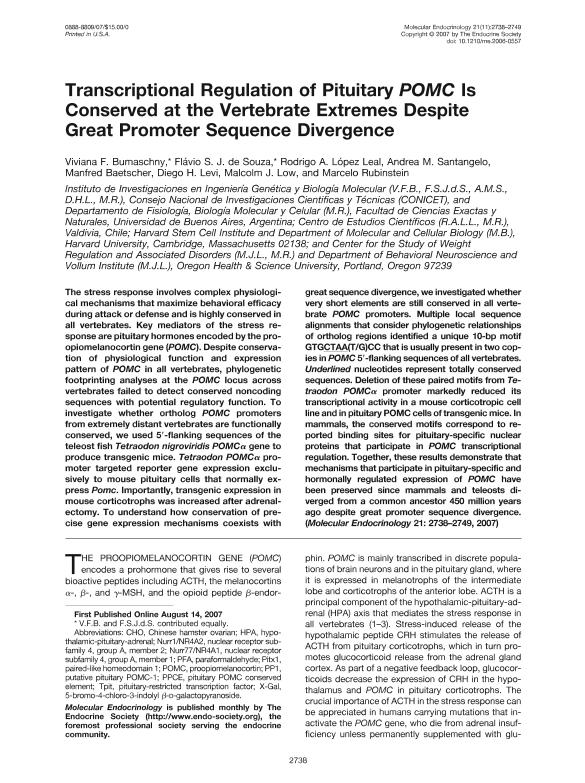Artículo
Transcriptional regulation of pituitary POMC is conserved at the vertebrate extremes despite great promoter sequence divergence
Bumaschny, Viviana Florencia ; Silva Junqueira de Souza, Flavio
; Silva Junqueira de Souza, Flavio ; López Leal, Rodrigo A.; Santangelo, Andrea Mariana
; López Leal, Rodrigo A.; Santangelo, Andrea Mariana ; Baetscher, Manfred; Levi, Diego H.; Low, Malcolm J.; Rubinstein, Marcelo
; Baetscher, Manfred; Levi, Diego H.; Low, Malcolm J.; Rubinstein, Marcelo
 ; Silva Junqueira de Souza, Flavio
; Silva Junqueira de Souza, Flavio ; López Leal, Rodrigo A.; Santangelo, Andrea Mariana
; López Leal, Rodrigo A.; Santangelo, Andrea Mariana ; Baetscher, Manfred; Levi, Diego H.; Low, Malcolm J.; Rubinstein, Marcelo
; Baetscher, Manfred; Levi, Diego H.; Low, Malcolm J.; Rubinstein, Marcelo
Fecha de publicación:
11/2007
Editorial:
Endocrine Society
Revista:
Molecular Endocrinology
ISSN:
0888-8809
Idioma:
Inglés
Tipo de recurso:
Artículo publicado
Clasificación temática:
Resumen
The stress response involves complex physiological mechanisms that maximize behavioral efficacy during attack or defense and is highly conserved in all vertebrates. Key mediators of the stress response are pituitary hormones encoded by the proopiomelanocortin gene (POMC). Despite conservation of physiological function and expression pattern of POMC in all vertebrates, phylogenetic footprinting analyses at the POMC locus across vertebrates failed to detect conserved noncoding sequences with potential regulatory function. To investigate whether ortholog POMC promoters from extremely distant vertebrates are functionally conserved, we used 5′-flanking sequences of the teleost fish Tetraodon nigroviridis POMCα gene to produce transgenic mice. Tetraodon POMCα promoter targeted reporter gene expression exclusively to mouse pituitary cells that normally express Pomc. Importantly, transgenic expression in mouse corticotrophs was increased after adrenalectomy. To understand how conservation of precise gene expression mechanisms coexists with great sequence divergence, we investigated whether very short elements are still conserved in all vertebrate POMC promoters. Multiple local sequence alignments that consider phylogenetic relationships of ortholog regions identified a unique 10-bp motif GTGCTAA(T/G)CC that is usually present in two copies in POMC 5′-flanking sequences of all vertebrates. Underlined nucleotides represent totally conserved sequences. Deletion of these paired motifs from Tetraodon POMCα promoter markedly reduced its transcriptional activity in a mouse corticotropic cell line and in pituitary POMC cells of transgenic mice. In mammals, the conserved motifs correspond to reported binding sites for pituitary-specific nuclear proteins that participate in POMC transcriptional regulation. Together, these results demonstrate that mechanisms that participate in pituitary-specific and hormonally regulated expression of POMC have been preserved since mammals and teleosts diverged from a common ancestor 450 million years ago despite great promoter sequence divergence.
Palabras clave:
Pomc
,
Tetraodon
,
Evolution
,
Pituitary
Archivos asociados
Licencia
Identificadores
Colecciones
Articulos(INGEBI)
Articulos de INST.DE INVEST.EN ING.GENETICA Y BIOL.MOLECULAR "DR. HECTOR N TORRES"
Articulos de INST.DE INVEST.EN ING.GENETICA Y BIOL.MOLECULAR "DR. HECTOR N TORRES"
Citación
Bumaschny, Viviana Florencia; Silva Junqueira de Souza, Flavio; López Leal, Rodrigo A.; Santangelo, Andrea Mariana; Baetscher, Manfred; et al.; Transcriptional regulation of pituitary POMC is conserved at the vertebrate extremes despite great promoter sequence divergence; Endocrine Society; Molecular Endocrinology; 21; 11; 11-2007; 2738-2749
Compartir
Altmétricas



